|
Saving Files
I see a lot of people who save files to their computer but have no idea where they were saved. This is typically because they don't understand the directory/file structure of their computer. You should look at the hard drive as a large file cabinet (as you have in your home or at work). In that file cabinet, there are multiple drawers. In those drawers are folders. The hard drive is set up in essentially the same way. You have the hard drive, directories (folders) and sub-directories (sub folders). There could be any number of levels. When you save something, you should save it to a place that you know well and can access easily. Many people use the desktop but that can make a mess. For now, I'm going to explain how to make a single folder for all of your files. If you want to make sub-folders later, that's fine. For now, find one of the links to 'My Computer'. There's one on the desktop (usually) and one in the start menu. Let's use the one in the start menu. Click on it. It will bring up a page that looks similar to the following image.
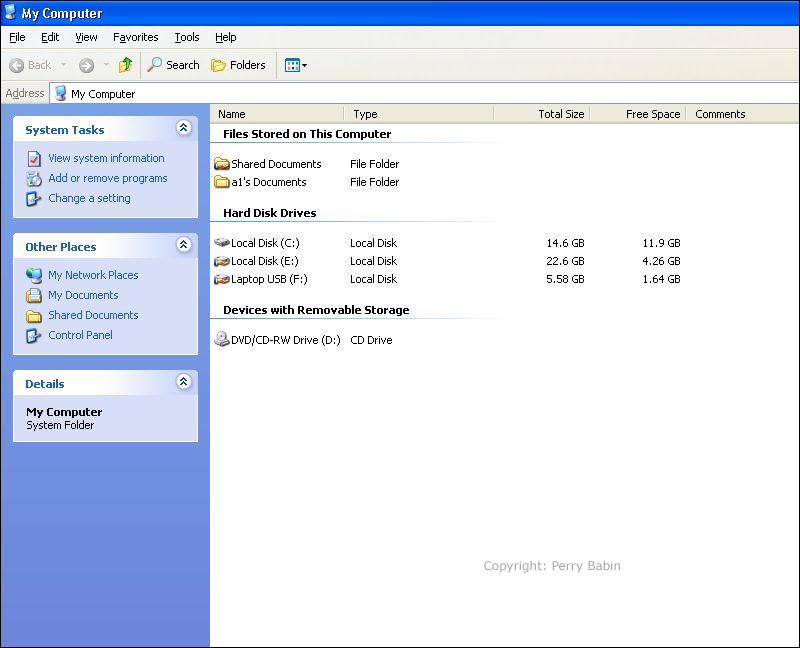
In the image above, you should notice a few things. It shows the drives, the total space and the available space. As you can see, there are 3 hard drives. Drives C and E are actually different sections (partitions) of the same drive (I'll explain partitions later). In this view, however, you can not see the directory structure. To see that, click on the button labeled 'folders'. You will see the pane on the left change from 'common/system tasks' to the hierarchical directory structure. The results should be similar to the next image.
IMPORTANT:
When working in the file manager (called Windows Explorer in Windows XP), you have to be very careful not to disturb any important files. In Windows Explorer, you can move files by dragging and dropping them. You have to be careful not to accidentally/unintentionally drag/drop any files when moving your mouse.
Note:
If your 'my computer' page looks significantly different than mine (it's going to be somewhat different due to having different files stored on the 2 computers), it's likely that you have it to display something other than 'details'. Go to the top of the page and click on the button named 'views' or go to the word 'view' (no 'S' on it) and select details. If you were looking at images, you may want to select 'thumbnails'. Try all of the different views. For now, to make your page as similar as possible to mine, set the view to 'details'.
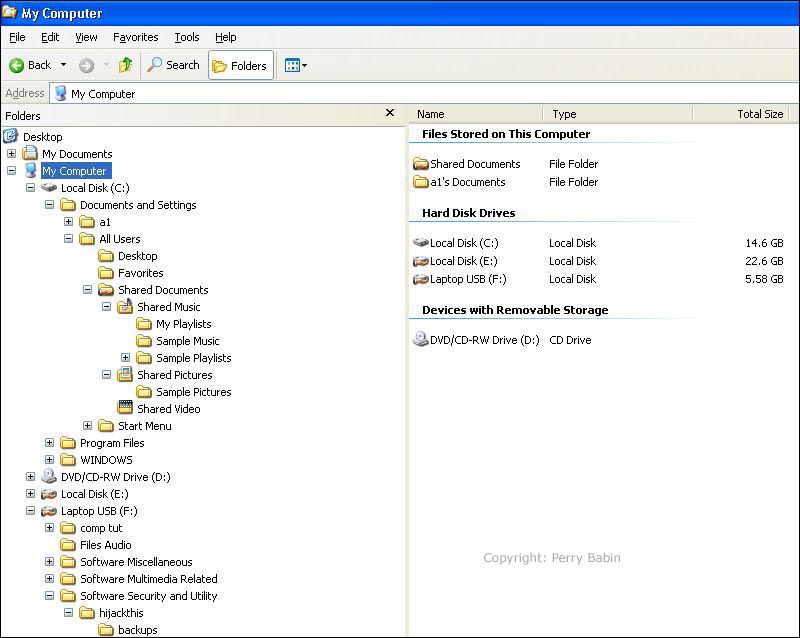
In the image above, you can see that there are a lot of little '+' symbols. These indicate that there are more files/folders in that particular folder. Clicking on the + will expand the directory if there are more 'folders' in it. OK, that's all you need to see in the 'folder view'. Click on the 'folders' button again to return the the original view.
As I said before, you are going to need to create a folder that you can easily find. To do this, double-click on the 'C' drive. When you double-click the C-drive, it will display the list of the files on the C-drive. To make sure that none of the files are highlighted, click in a clear space in the right pane. In the left pane, there is a link named 'make a new folder'. Click on it. When you click on it, you will see a new folder pop-up and the name 'NEW FOLDER' will be highlighted. While it's highlighted, type a new, distinctive name that you will easily remember and hit the 'enter' button to finish. I named mine 'This is the new folder I added'.
Notes:
* Above, we discussed renaming file names. When a file is selected/highlighted, it's appearance changes. If you click on the file once, it will change color (typically to the base color of the color scheme your using). If you click it again after a short pause (at least 1 second), it will change to a different type of highlighting where only the text is highlighted. The two images below show what each looks like. The first is after a single click on the file. The second shows the file after a delayed second click. The same thing can be accomplished by right-clicking the file and selecting 'rename'.


* If you have Windows Explorer set to display folders instead of common tasks, you can right-click on a clear space in the right pane and select NEW >> FOLDER.
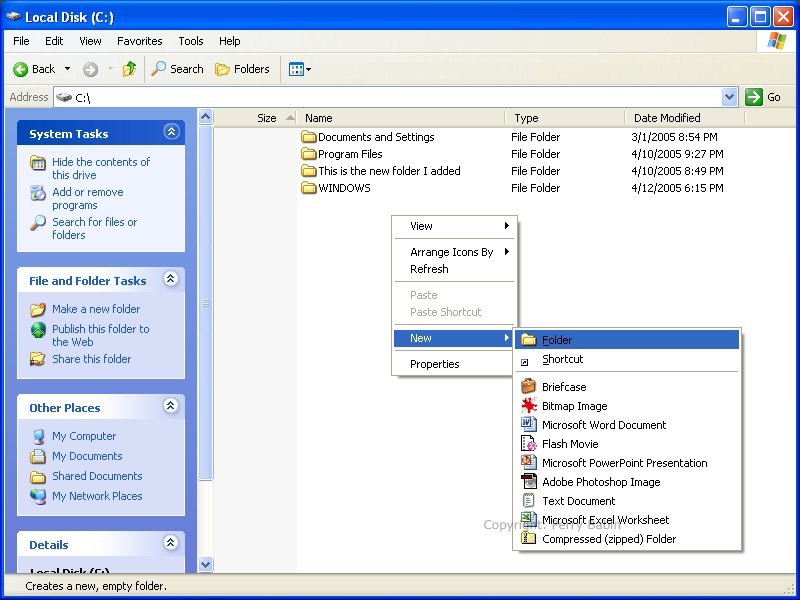
When you try to save something from the internet, select the FILE >> SAVE AS option. A dialog box will pop up. It will have a list of drives and folders. If you don't see your newly created folder, use the 'up one level' button (folder with a green arrow -- shown below) until you see the C-drive. When you see the C-drive, double-click it. You should then see your folder. Double-click your folder to enter it. When you're in your folder, click the 'save' button on the dialog box.
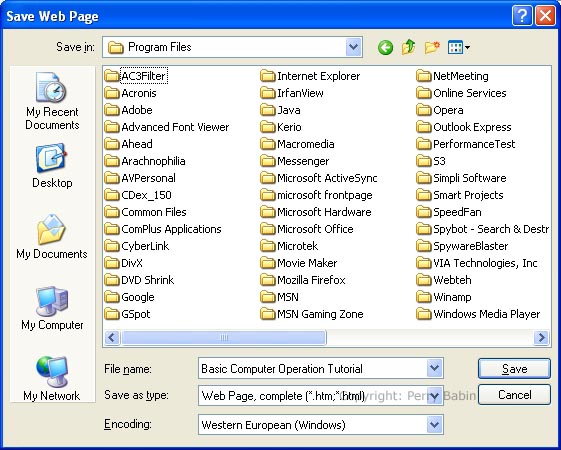
Note:
If we were to click the save button with things as they are in the image above, it would be saved in the 'program files' folder. You can tell what folder you're in by looking at the field next to 'save in:'. When you're in your folder, its name will be in that field.
Retrieving Stored Files
If you store all of your incoming files in the folder that we discussed above, you can easily retrieve them. From the desktop, simply double-click the 'My Computer' icon. If you want to access it from the 'Start Menu', go to START >> MY COMPUTER. Either way, you will see the list of drives on your computer. If you double-click the C-drive, you will be presented with a list of the folders on the drive. The file you previously created will then be visible. Double-click your folder to open/enter it.
Note:
Most people store their personal files in the 'MY' folders (my documents, my music, my pictures...). I prefer not to store the files there. If your computer crashes in a way that causes the operating system to fail and you have to reload the operating system, the files in those folders may be destroyed. I prefer to have the files stored on a different partition from the operating system or on a second hard drive. This ensures that they are not destroyed when the operating system is reloaded. Of course, it's good to have back-up copies of all of your files. That will be covered later
Drive Letters:
As you probably noticed, there were multiple drive letters (c, d, e and f) on the computer that I'm using in this tutorial. Your computer may have only 2 drives or it may have more. Don't let this confuse you. On MOST computers, C-drive is the drive where the operating system (Windows, Linux...) is located. Typically this is the drive where virtually everything is stored. On MOST computers, D-drive is the CD-ROM or DVD-ROM drive. To let you see how removable drives or new drives may change the drive letters, I connected a camera and added a new CD ROM drive. The image below shows you how the drives were renamed when the comptuer was rebooted. The laptop drive in the portable enclosure changed to 'D'. The CD ROM drive is drive 'F'. The DVD ROM drive changed to 'G' and the camera is listed as 'I'.
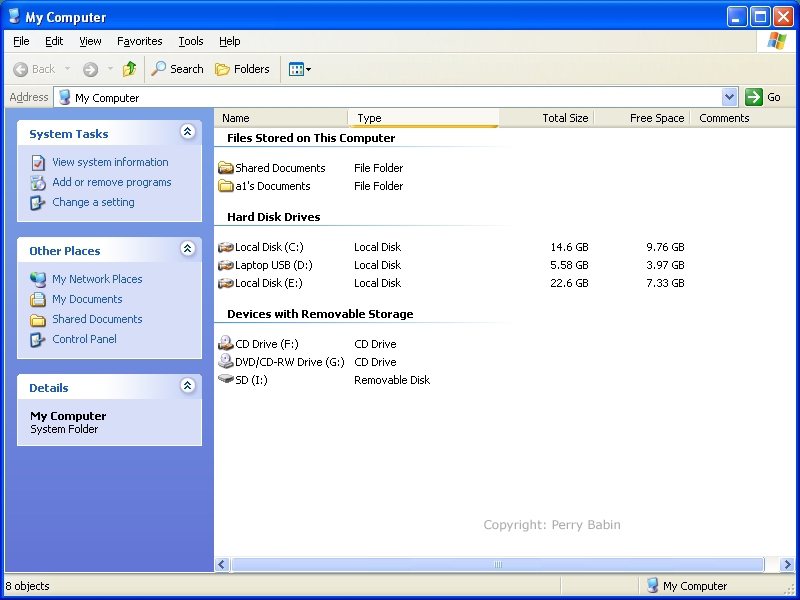
File Types:
Since Windows hides file types by default, you may not know that there are many types of files. The file type is indicated by the file extension. The 'extension' is the part of the file name after the 'dot' in the file name. For example, the file name 'flower.jpg' (flower-dot-jpg) has an extension of 'jpg'. So that you can see the extensions, open MY COMPUTER >> TOOLS >> FOLDER OPTIONS >> click the VIEW tab >> scroll down and de-select 'hide extensions for known file types' >> click OK to exit. Now, the various file extensions will be shown. The following list shows some of the file types and a few of they the extensions that they may have:
- Still Image Files: .JPG, .GIF, .BMP, .PNG
- Web/Internet Files: .HTM, .HTML, .SHTML
- Text/Document Files: .TXT, .DOC, .WPD
- Video Files: .AVI, .MPG, .MPEG, .MKV, .OGM
- Adobe Acrobat Files: .PDF
- Compressed Files: .ZIP, .RAR
File Associations:
To use any file, there has to be some appropriate software to open/view/run the file. If you try to access one of the files that you've saved, you have to have that type of file associated with some sort of software. For example, if you saved a file from the web with an HTML extension and you double-clicked it, it would open your default browser. For Windows, the default browser is Internet Explorer. Windows knows this and when you double-click the HTML file, Windows launches Internet Explorer. The same thing happens for all files that have an associated program. Sometimes, you will double-click a file and you get a pop-up saying that there is no file association. In Windows XP, it will give you two options. The first option is that Windows will look in an on-line database to see what software is associated with the file you tried to open. The list of software you will receive is by no means complete but it will typically allow you to find some compatible software that will allow you to open the file. Luckily, Windows comes with the software that you need to open most common files.
Windows' Unsupported File Types:
Windows does not provide compatible software for a few very common file types. One type is the PDF (Portable Document Format) file. It's generally opened by Adobe Acrobat. Acrobat is a free PDF viewer (can't edit the files but will allow you to view them). You can get it at the Adobe.com site. If you click on a PDF file (before Acrobat is installed) you will either be directed to the Adobe site or you may see the pop-up dialog box mentioned in the previous section. If you go to the Adobe site, you will see the link to the Adobe Acrobat reader. If you click on the link/button, you will be sent to a page with several drop-down option menus. You will need to select the options for your particular system (your computer and it's configuration). The choices are typically 'operating system' (Windows XP for most computers), the internet 'connection' type (DSL, cable, dial-up...) and there may be a few others. After selecting the proper options, there will likely be a 'continue' or 'download' button. Eventually, you will get to a point where you will see a pop-up dialog box asking whether you want to save or open the file. For this particular instance (installing Acrobat), you would select RUN. If you were downloading an image or music or video file, you would want to SAVE it to the desired folder (assuming that you'd want to view/use the file at a later date). As part of the installation of the software, the proper file associations will be set. After the installation is complete, Acrobat will be launched automatically when a PDF file is to be opened.
Note:
The previous paragraph dealt with installing one particular program for one particular file type. The installation process will not be precisely the same for all programs but this should give you a pretty good idea of what you'll need to do when you have an unsupported file type (relatively rare after the computer is set up). Later in the tutorial, I cover the installation of another program in detail.
Changing File Associations when Loading New Software:
As you probably already know, there are multiple programs that will open a particular file. For example, in Windows, the Windows Media Player is the default video player. If you double-click on a music video file, Windows will automatically launch Windows Media Player. Windows Media Player is a fine, powerful program that can perform quite a few tasks. The problem is... this ability causes it to be a huge program. I prefer a smaller program that's dedicated to doing only a few tasks but doing them well. My choice at this point in time is the BS Player. It has all of the features and functionality I need and the interface is much better (in my opinion) than that of the WMP.
Let's say that you want an alternative to the default media player. If you were to install another media player (BS Player is only one option), it would likely be able to play all sorts of files. During some point in the installation it would (should) ask you if you want to associate it with a list of files. in many instances, virtually all file types in the list are checked. To prevent having any unintended problems, you should de-select all but one or two file types. If you're wondering how you'll know what file types you want to associate, it's the type(s) for which you downloaded the new media player. For example, if you didn't like the interface on WMP when watching music videos (mostly MPGs and MPEGs) then you'd only tell the new software to change the associations for those two types (during the installation). If you want to change the file association for a different file type after the installation, you can usually do it in the 'preferences' or 'options' dialog boxes (often accessed via a RIGHT-click when the player is active). If you decide that you don't like the new player, when you un-install it, the file associations will (if the software was properly written) revert to the previous default player.
Manually Changing File Associations:
If, at some point, you need to change a file association or want to see what piece of software is associated with a file that isn't opening properly, you can go to MY COMPUTER >> TOOLS >> FOLDER OPTIONS >> click on the FILE TYPES tab. It may take a few seconds for the list to appear. The 'extensions' are listed in alphabetical order by default. You can scroll down to the file type you're having trouble with and it will tell you the program with which it's associated. At this point, it may be too difficult for the reader to manually change a file association so I'll cover that later.
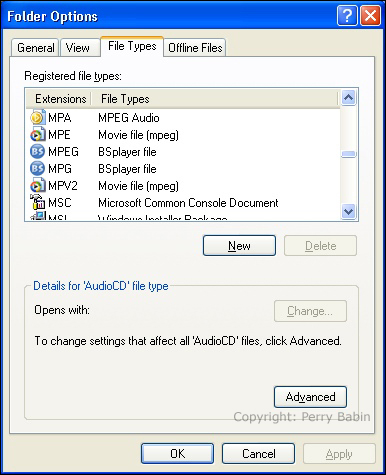
|
You May Be Interested in My Other Sites
-
This site was started for pages/information that didn't fit well on my other sites. It includes topics from backing up computer files to small engine repair to 3D graphics software to basic information on diabetes.
-
This site introduces you to macro photography. Macro photography is nothing more than the photography of small objects. It can take quite a while to understand the limitations associated with this type of photography. Without help, people will struggle to get good images. Understanding what's possible and what's not possible makes the task much easier. If you need to photograph relatively small objects (6" in height/width down to a few thousandths of an inch), this site will help.
-
If you're interested in air rifles, this site will introduce you to the types of rifles available and many of the things you'll need to know to shoot accurately. It also touches on field target competition. There are links to some of the better sites and forums as well as a collection of interactive demos.
-
This site is for those who want to install or update their car stereo. It begins with the most basic electronics theory, progresses into basic transistor theory as well as covering virtually everything associated with car audio.
|
|







